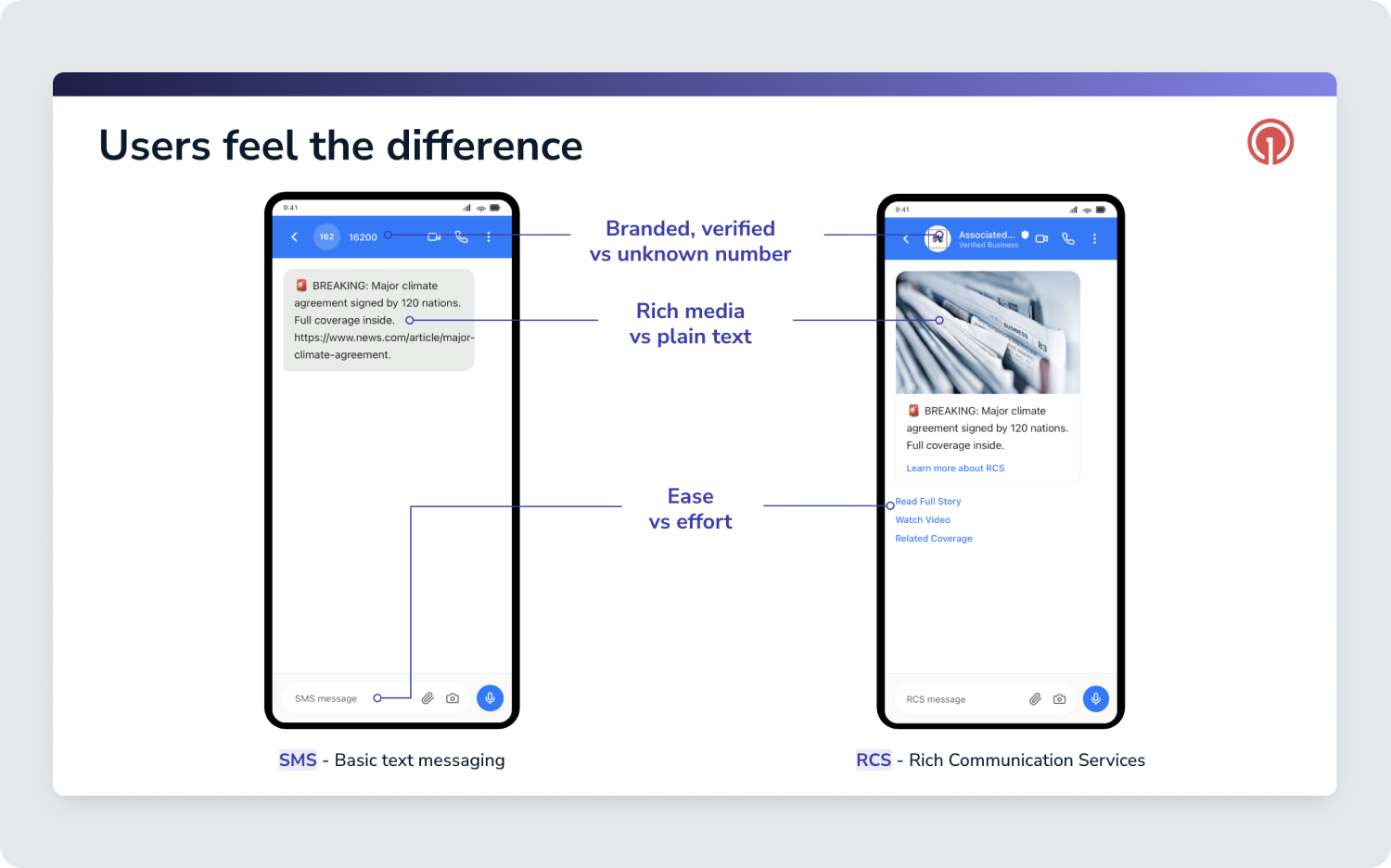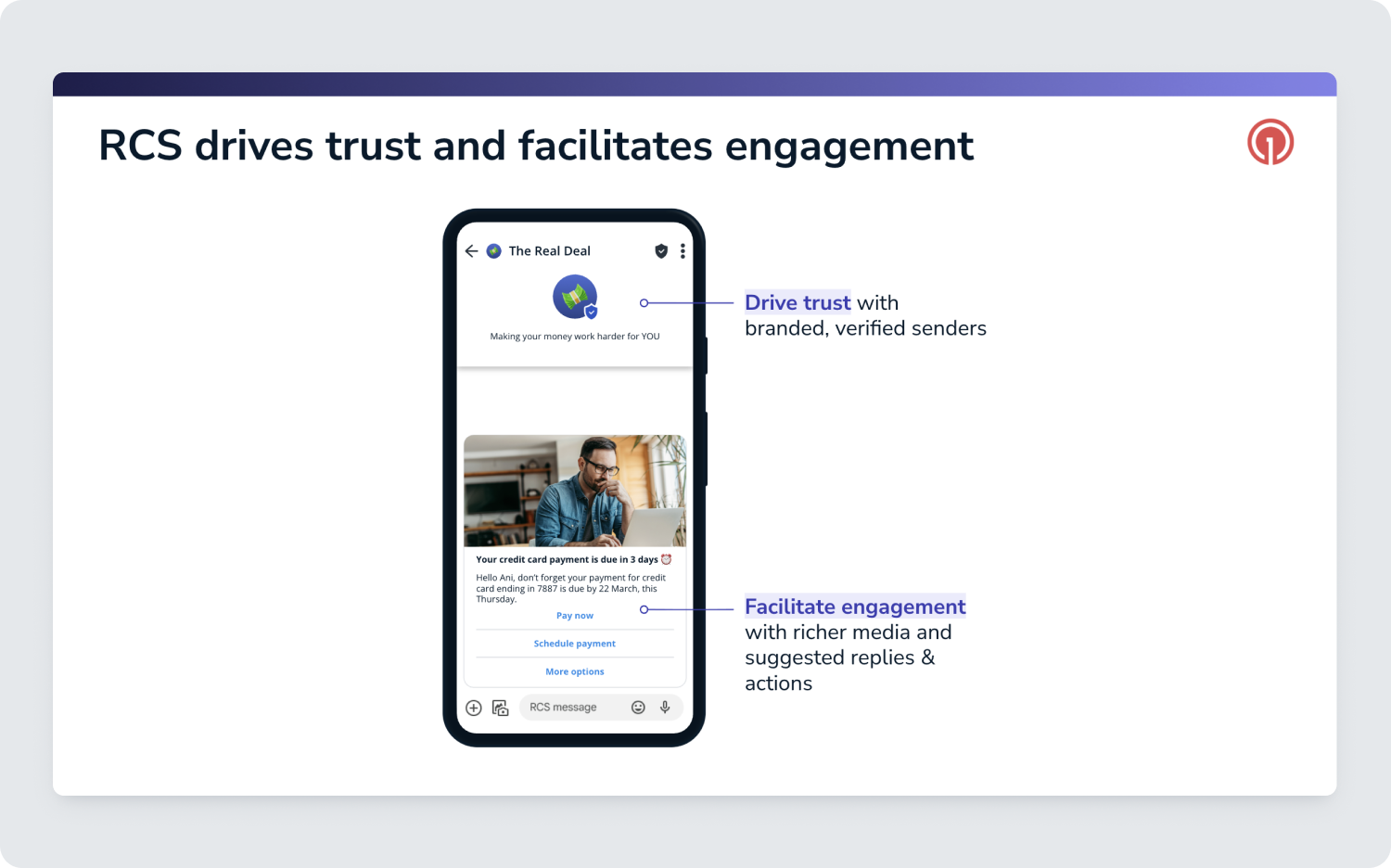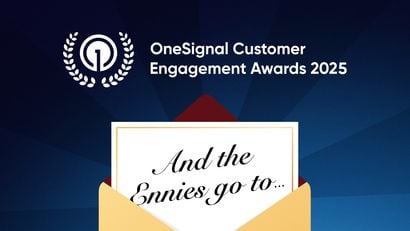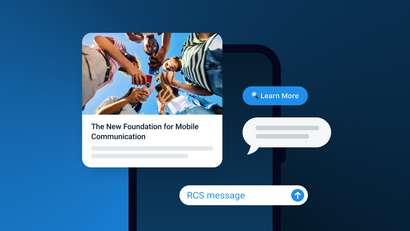The saturation of the campaign era is ending.
For nearly two decades, we’ve measured marketing success by scale: reach, volume, and cost per impression (CPI). We optimized the broadcast.
But customers don’t reward reach anymore, instead they reward relevance. They want communication that feels timely, contextual, and deeply human. This has opened a critical gap between how we market and what customers expect.
The data confirms this challenge: 91% of customers globally expect real-time assistance. And businesses that have embraced conversational engagement are already seeing up to 80% higher sales.
You can no longer afford to be shouting into the void. The new question is simple: What value does each conversation create?
That’s where Rich Communication Services (RCS, or “Really Cool SMS”) comes in- transforming the humble text message into a secure, branded, interactive experience that unlocks dialogue.
Get the real game-changers in this direct comparison of SMS vs. RCS.

From CPM to VPC: Recalibrating conversational ROI
Campaigns measure efficiency. Conversations measure impact.
RCS moves us beyond traditional Cost Per Message (CPM) into what we can start thinking of as Value Per Conversation (VPC), a more natural way to measure RCS in action. Instead of asking, “How cheaply did we send this?” we begin asking, “What did this interaction create for the business and the customer?”
Where ARPU (Average Revenue Per User) looks at revenue per user over time, VPC zooms in on the value of each interaction or thread – the incremental revenue generated, the renewal it influences, the satisfaction it drives, and the trust gained (or lost) in each exchange.
As messaging becomes richer, two-way, and transaction-ready, this “value per conversation” lens becomes essential to understanding the real ROI of RCS, where success is defined by the depth of conversation and measurable business outcomes:
- RCS messages achieve impressive 90–95% open rates
- Rich content generates 15–30% click-through rates
- Conversational automation drives 30%+ lower service costs
Once engagement becomes a two-way street, your customers can finally graduate from tapping to trusting.
Where does RCS fit in your conversion funnel? It’s a valid question! This guide to RCS ROI lays out the path to conversion at each stage.
The in-thread revolution: Zero friction, full flow
Every redirect is a drop-off. Every click away is a lost moment.
The power of RCS is that it keeps the customer in-thread - everything happens inside one continuous conversation. Imagine you get a message about a delayed order: in the same thread you can tap to see updated delivery options, change the time, confirm the new plan, and get a receipt. No app switching, no logging in, no hunting for links.
To the end user, it feels like one uninterrupted interaction rather than a series of disconnected steps. That’s the difference between a broken journey and a seamless one. This kind of frictionless experience isn’t a nice-to-have anymore- it’s what customers now expect: 86% of people say they prefer messaging to other channels, and 63% will switch brands for a better conversational experience.
Want to see RCS in action, these RCS marketing examples are a great way to visualize the experience!

AI + RCS: Where empathy scales
When you layer AI on top of RCS, the goal isn’t just to reply faster - it’s to respond smarter and more personally at every step of the journey.
In practice, that can look like:
- Smarter targeting: AI predicts who’s likely to reorder, churn, or need support, so RCS outreach is timely and relevant instead of generic.
- Adaptive messaging: AI helps shape the content of the message - adjusting copy, offers, and CTAs based on past behavior, preferences, or context.
- Guided in-thread conversations: AI can handle routine questions (order status, simple changes, FAQs), surface the right rich cards or buttons, and then smoothly hand off to a human when nuance, emotion, or complexity shows up
Recent industry research shows that AI-assisted customer engagement can boost revenue by 5-8% and reduce support costs by around 20–30%.
When it’s done well, the experience doesn’t feel “automated” to the customer - it feels like the brand understands what they need, when they need it, and responds with the right level of help in one continuous thread. AI becomes the engine that makes that kind of empathy possible at scale.
Trust is the new KPI
In a sea of spam and one-way communications, trust is the growth metric that matters most.
RCS builds trust right into the experience: verified sender IDs, brand logos, and carrier-backed security. When people know who’s messaging them, they respond.
For example, Bouygues Telecom saw an 80% lift in conversions with RCS videos embedded in billing messages. Trust isn't fluffy - it's measurable loyalty.
Conversational search: Intent meets immediacy
Search is fundamentally changing. When customers find your brand, they’ll expect to start chatting instantly. No forms, no waiting.
Google’s Business Messages framework already allows verified RCS conversations directly from search. This is the moment where discovery, dialogue, and decision merge into one. The funnel is collapsing - replaced by a single, fluid moment of intent.
The metrics that actually matter
Let’s rewrite the marketing scorecard. Marketing success is no longer measured by how much you send, but by how deeply you connect. The strategic shifts we must track are:
- From efficiency to value: We measure revenue per conversation, not cost per message.
- From transactions to relationships: We prioritize customer lifetime value (CLV) over short-term conversion rate.
- From scale to depth: We track depth of engagement over volume of sends.
- From reach to retention: We focus on loyalty and trust over CPA (Cost Per Acquisition)
This shift isn’t abstract - it shows up directly in how teams design their programs. Imagine a subscription streaming brand that used to run a quarterly “win-back” email campaign focused purely on driving down Cost Per Acquisition (CPA).
Instead, they rebuild that motion as a conversational RCS journey: lapsed users receive a rich, in-thread message with tailored show recommendations based on viewing history, quick-reply buttons to restart their subscription, and an option to chat if something didn’t work last time. The goal isn’t just to get a click - it’s to understand the customer’s context and remove friction in real time.
This shift delivers measurable operational results. Recent research shows that AI-powered, real-time personalization can increase customer satisfaction by 15–20%, while customer-obsessed organizations see 51% better customer retention than their peers.
Beyond “Really Cool SMS”: The conversation ecosystem
RCS may be the cornerstone, but the future is interconnected. Conversation is the connective fabric of modern engagement:
- RCS: For verified, interactive mobile messaging.
- AI: As the orchestration layer connecting every touchpoint.
The conversational commerce market is no longer a niche experiment - it’s scaling fast. Recent research estimates the global conversational commerce market at $17.2 billion in 2024, projected to reach $56.9 billion by 2030.
This shift requires more than new tools; it requires a new mindset. In a 2025 global study, 93% of CMOs reported that generative AI is already delivering clear ROI for their marketing organization
The future belongs to teams that treat conversation as a strategic asset - listening as carefully as they lead.
The future of engagement
The momentum around RCS has moved beyond promise into performance. Industry analysis now suggests that RCS traffic is expected to quadruple over five years, from roughly 1.5 trillion messages in 2024 to more than 6 trillion by 2029.
Taken together, these trends signal a fundamental reality: the mobile inbox is no longer just a message feed - it is rapidly becoming your storefront, support desk, and loyalty engine, all in one place.
Key takeaways: The next chapter of engagement
To lead this new era, audit your messaging and ask:
- Shift from campaigns to conversations. Stop counting impressions -start creating interactions.
- Design for trust. Verification, transparency, and empathy drive conversion.
- Measure value per conversation. It’s the metric that reflects true ROI.
- Let AI amplify empathy. Technology should make connections easier, not colder.
- Listen, then lead.
Because at the end of the day, the most powerful message isn’t one that’s sent -it’s one that’s shared, remembered, and replied to.
The conversation is the conversion.
Building real relationships with rich messaging
As messaging channels evolve, RCS stands out for one reason: results. OneSignal helps your brand get approved for RCS faster, launch faster, and grow faster… all while tying RCS into your broader omnichannel Journeys.
The outcome? More connected customer experiences, less operational complexity, and measurable revenue impact across your messaging mix.
Reach out to our team to get started with a trial or to get your approval process started now!




